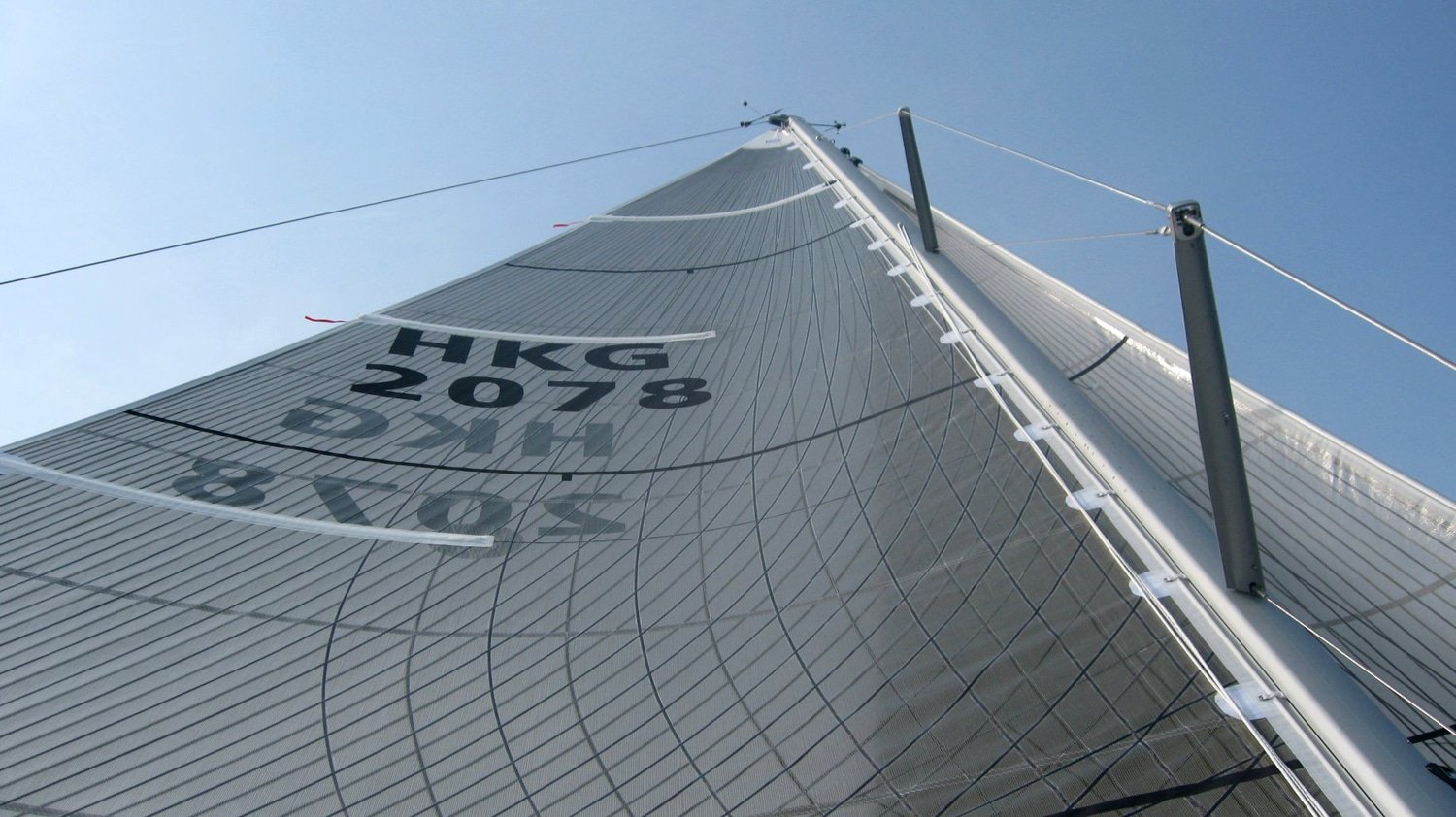
4.1 – The Sails – Mainsail
There is occasionally some confusion with respect to mainsail area. Most sailmakers, including us, compute mainsail area as if the sail were a right triangle with three straight edges. With this method, area equals the luff times the foot divided by two. Most mainsails are, in fact, somewhat larger than that by reason of the extra area at the leech, called roach, which falls outside the straight line triangle. The promotional material distributed by boat builders and dealers sometimes includes this extra area as part of mainsail area. If they’re using the same luff and foot dimensions, they’re talking about the same sail in spite of the different figure for area. When we make mainsails, we’ll include as much roach, not only on the leech, but also on the luff and foot, as is practical and proper for the particular sail.
Reefs
Mainsail reefs are used to depower a boat in strong winds. Reefing makes the mainsail smaller. Each row of reefs consists of a heavily reinforced patch with a grommet at the luff for the tack horn and a grommet at the leech for the reefing outhaul. Between the reefed tack and clew may be a row of evenly spaced smaller grommets (called reef diamonds) to provide a means of gathering up and tying off the excess sail. This row of holes is omitted in the case of a flattening reef because there is not enough excess material to worry about. The number of area-reducing reefs varies with the size and anticipated use of the sail.

Full Length Battens
Full-length battens have many virtues for cruising sailors, including better shape-holding, more longevity, and easier sail handling. The sails last longer because the full-length battens prevent flogging (the violent snapping back and forth that occurs when tacking, reefing, hoisting or lowering the mainsail). As conventional sails flog, the sailcloth breaks down, especially at the front end of the battens where the leech of the sail “hinges” back and forth. Flogging is the prime culprit in sail wear-and-tear.
Full-length battens induce a smooth airfoil shape to the mainsail, improving performance in all conditions. In light air, the full-length battens hold shape instead of the sail sagging; the battens also prevent slatting as the boat rolls in light wind and waves. In heavy air, the full-length battens keep the sail from flogging when the sheet is eased to reduce heeling: the silence is a pleasant surprise. Full-length battens also prevent the draft of the sail from moving aft in heavy air when sailing upwind.
Downwind, in light and heavy wind, full-length battens support the leech of the main, providing more projected sail area, which makes your boat faster
The Powerhead Main
The Powerhead is the right batten configuration for those who both cruise and race. No matter what construction option you choose, the Powerhead’s full-length top batten gives many of the durability benefits of a full-batten main, while offering performance advantages for sailing faster upwind as well as downwind.
The Powerhead is a faster sail than a standard mainsail because the full-length top batten creates more roach. This extra area toward the top of the sail enables a more effective aerodynamical shape that allows a boat to point higher upwind and gives more sail area for sailing downwind.

The full-length top batten stabilizes the leech allowing UK to build a maximum-roach sail. The long batten increases longevity by minimizing the damaging effects of luffing and by preventing the draft of the sail from moving aft over the years. To support the large leech on lower aspect sails, UK Sailmakers also offers the option of making a second batten full length.

Square Top
Square Top mainsails may help improve your performance with minimumal change to your rating. By increasing the sail area at the top of the mainsail, air flow across this wider section of sail can be stabilized, reducing the tip vortices. With the right design, drag can be reduced; therefore, producing a higher aspect and more effective sail, which helps to improve downwind and upwind speed.
Shelf Foot and Loose Foot
The Shelf-Foot and Loose-Foot constructions are options that allow us to add a substantial degree of extra fullness in the lower portion of the mainsail in order to improve racing performance on reaches and runs. In very light air, the improved performance is achieved even to windward. The extra fullness is removed by tightening the outhaul. When the outhaul is eased, the sail maintains an airfoil shape down to the boom. With the Shelf-Foot option, a light piece of material connects the sail to the boom. With the outhaul eased, the connecting material unfolds and forms a shelf between the bottom of the main and the boom. When the outhaul is pulled tight, the shelf closes up and lays against the side of the boom.
Loose-Foot construction does away with the shelf material. The sail is only attached to the boom at the tack and clew. This attachment method is equally as strong as that of the foot attached to the boom. Many boats are switching to Loose-Footed mains because they make it easier to bend on your mainsail and to remove the sail from the boom — and it’s less expensive.


